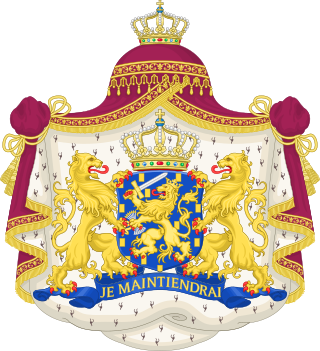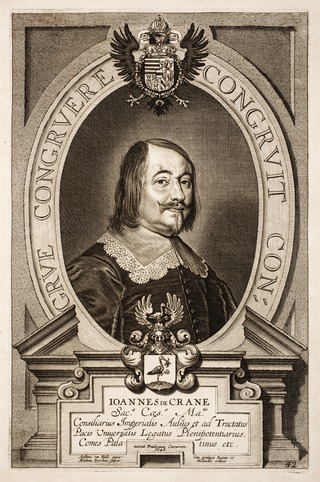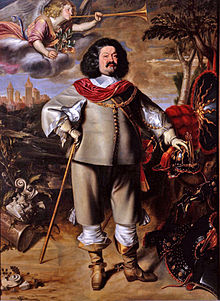
The House of Orange-Nassau is the current reigning house of the Netherlands. A branch of the European House of Nassau, the house has played a central role in the politics and government of the Netherlands and elsewhere in Europe, particularly since William the Silent organised the Dutch Revolt against Spanish rule, which after the Eighty Years' War (1568–1648) led to an independent Dutch state. William III of Orange led the resistance of the Netherlands and Europe to Louis XIV of France and orchestrated the Glorious Revolution in England that established parliamentary rule. Similarly, Queen Wilhelmina of the Netherlands was instrumental in the Dutch resistance during World War II.

William II was sovereign Prince of Orange and Stadtholder of Holland, Zeeland, Utrecht, Guelders, Overijssel and Groningen in the United Provinces of the Netherlands from 14 March 1647 until his death three years later on 6 November 1650. His death marked the beginning of the First Stadtholderless Period, leading to the rise of Johan De Witt, who stayed in power for the next 22 years.

Frederick Henry was the sovereign prince of Orange and stadtholder of Holland, Zeeland, Utrecht, Guelders, and Overijssel in the Dutch Republic from his older half-brother's death on 23 April 1625 until his death on 14 March 1647. In the last seven years of his life, he was also the stadtholder of Groningen (1640-1647).

GovertTeuniszoon Flinck was a Dutch painter of the Dutch Golden Age.

John Maurice of Nassau, called "the Brazilian" for his fruitful period as governor of Dutch Brazil, was Count and Prince of Nassau-Siegen. He served as Herrenmeister of the Order of Saint John from 1652 until his death in 1679.

Amalia of Solms-Braunfels was Princess of Orange by marriage to Frederick Henry, Prince of Orange. She acted as the political adviser of her spouse during his reign, and acted as his de facto deputy and regent during his infirmity from 1640 to 1647. She also served as chair of the regency council during the minority of her grandson William III, Prince of Orange from 1650 until 1672.

The Eighty Years' War or Dutch Revolt was an armed conflict in the Habsburg Netherlands between disparate groups of rebels and the Spanish government. The causes of the war included the Reformation, centralisation, excessive taxation, and the rights and privileges of the Dutch nobility and cities.

Abraham van Diepenbeeck was Dutch painter, draftsman, glass painter, print maker and tapestry designer who worked most of his active career in Antwerp. He designed glass windows for various churches and monasteries in Antwerp for which he made many design drawings and oil sketches. He engraved and designed many prints which were published by prominent Antwerp printers such as van Meurs, the Plantin Press and Martinus van den Enden the Elder. He had a close relationship with the workshop of the leading Flemish Baroque painter Peter Paul Rubens and collaborated on various projects under the direction of Rubens. In the 1630s van Diepenbeeck started to create monumental paintings. His work was influenced by Rubens and Anthony van Dyck.

Bartholomeus van der Helst was a Dutch painter. Considered to be one of the leading portrait painters of the Dutch Golden Age, his elegant portraits gained him the patronage of Amsterdam's elite as well as the Stadtholder's circle. Besides portraits, van der Helst painted a few genre pictures as well as some biblical scenes and mythological subjects.
The Peace of Münster was a treaty between the Lords States General of the Seven United Netherlands and the Spanish Crown, the terms of which were agreed on 30 January 1648. The treaty, negotiated in parallel to, but not part of, the Peace of Westphalia, is a key event in Dutch history, marking the formal recognition of the independent Dutch Republic and the end of the Eighty Years' War.

Gaspar de Crayer or Jasper de Crayer was a Flemish painter known for his many Counter-Reformation altarpieces and portraits. He was a court painter to the governors of the Southern Netherlands and worked in the principal cities of Flanders where he helped spread the Rubens style.

Michiel Janszoonvan Mierevelt was a Dutch painter and draftsman of the Dutch Golden Age.

Tethart Philipp Christian Haag was a Dutch artist and court painter to William V of Orange-Nassau and the director of cultural institutions in The Hague.

Adriaen Hanneman was a Dutch Golden Age painter best known for his portraits of the exiled British royal court. His style was strongly influenced by his contemporary, Anthony van Dyck.

Huis ter Nieuwburg or Huis ter Nieuburch was a palace in Rijswijk, Holland, Dutch Republic. The symmetrical French Classicist building was probably designed by the Dutch architect Jacob van Campen together with Constantin Huygens and the prince himself. According to Slothouwer the designs were carried out by Arent van's Gravesande who was replaced by the French architect Simon de la Vallée in 1634. The palace was built between 1630 and 1636 for stadtholder Prince Frederick Henry.

Paulus Pontius was a Flemish engraver and painter. He was one of the leading engravers connected with the workshop of Peter Paul Rubens. After Rubens' death, Pontus worked with other leading Antwerp painters such as Anthony van Dyck and Jacob Jordaens.

Banquet of the Amsterdam Civic Guard in Celebration of the Peace of Münster (1648) is a group portrait oil painting by the Dutch painter Bartholomeus van der Helst. It is an example of Dutch Golden Age painting and is considered one of the highlights of the Amsterdam Museum, though it is generally on show in the Rijksmuseum.

The Attack on Amsterdam in July 1650 was part of a planned coup d'état by stadtholder William II, Prince of Orange to break the power of the regenten in the Dutch Republic, especially the County of Holland. The coup failed, because the army of the Frisian stadtholder William Frederick, Prince of Nassau-Dietz got lost on the way to Amsterdam in the rainy night of 29 to 30 July. It was discovered, and once the city had been warned, it had enough time to prepare for an attack. The attempted coup made the House of Orange extremely unpopular for a lengthy period of time, and was one of the main reasons for the origins of the First Stadtholderless Period (1650–1672).

Triumph of Frederick Henry, Prince of Orange is a painting by the Flemish painter Jacob Jordaens, signed and dated at the bottom left "J JOR fec / 1652". It is located in the Oranjezaal in the Huis ten Bosch in The Hague, The Netherlands.

Mattheus Borrekens or Mattheus Borkens was a Flemish engraver, printmaker and draughtsman. He was a reproductive artist and worked on some important publications in the Southern Netherlands. He mainly treated Christian religious subjects and portraits.























